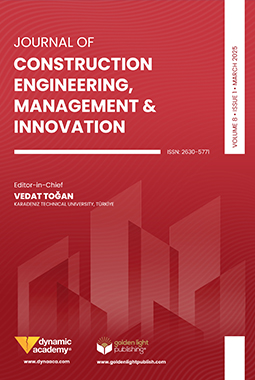ISSN:2630-5771
Journal of Construction Engineering, Management & Innovation
ARTICLES
Victor Yepes
Eloy Pérez-López
Julián Alcalá
Tatiana García-Segura
This paper presents a study of the parametric variability of post-tensioned concrete box-girder pedestrian bridges. SAMO2 algorithm is used for the parametric study. This algorithm combines SA with a mutation operator, to find the economic solutions. A span-length parametric study analyzes the characteristics for the best design of a three-span deck in which the main span ranges from 30 to 60 m. The depth and the number of strands were adjusted according to span length, while the thickness of the slabs presented the same optimum values in all cases. Results show that the amount of steel and volume of concrete per square meter of deck shows a good correlation with the main span length. This study demonstrates that by increasing the main span length by one meter, the total cost per square meter of the deck increases by 6.38 euros on average. Thus, this paper shows the relationship between the span length and geometrical and steel variables to produce and build a cost-efficient pedestrian bridge.
https://doi.org/10.31462/jcemi.2018.01067074
Emrah CINAR
Beliz OZORHON
Increased competitiveness forces construction companies to be more productive, efficient, effective, and better integrated. Enterprise resource planning (ERP) tools help construction companies improve their performance levels with the integration of different departments. ERP implementation is critical since the failure rates are high. The major objective of this research is to explore the challenges and key enablers of ERP implementation in construction firms. In this respect, a case study methodology has been employed to three large firms. The findings of the research indicate that reluctance of the employees, lack of scope management, and geographical barriers have been the most significant challenges that the implementation teams encounter. The key enablers to overcome those challenges have been top management support, business process reengineering, clear goals and objectives, competent team and leader, training, and consultancy. This study provides a better understanding of the critical issues of ERP implementation in construction. The findings are expected to guide construction professionals and ERP consultants in the implementation process.
https://doi.org/10.31462/jcemi.2018.01075084
Bünyamin Sağlam
Önder Halis Bettemir
An excavator is a construction machine that is used at constructions which involve earthworks. Pallet or wheeled ones are preferred according to the site conditions. When choosing an excavator, the unit cost of the excavation and the duration of the excavation task play an important role. There are various factors that affect efficiency of the excavator and speed of the excavation. Factors such as bucket volume of the excavator, bucket fill rate, cycle time, swing angle, type of excavated ground, as well as environment and weather conditions influence the performance of the excavators. In this study, software which estimates duration of the excavation and number of required trucks by considering different ground and environmental conditions is developed. Moreover the software takes hauling distances and job conditions into account. The developed software calculates statistically the effect of the uncertainties in the input parameters from the randomly generated numbers by the Monte Carlo Simulation method. The software is developed by C++ programming language. Developed software can be helpful for the state institutions and private firms to determine the risks of the time and cost estimates.
https://doi.org/10.31462/jcemi.2018.01085094
Gonca Kamber Yılmaz
Hasan Basri BAŞAĞA
It is important to investigate the parameters that have an impact on accident occurrence in light of the precautions that can be taken against possible occupational accidents. Statistics on work-related accidents in Turkey are gathered through Turkish Statistical Institute (TSI) and Social Security Institution (SSI). SSI shares occupational accident data online annually. These data, though, there is not a comprehensive data repository, are not boiled down to province-based and/or work branch specific data. In this study, it is aimed to be able to carry out an in-depth examination of occupational accidents in construction work. For the in-depth investigation of occupational accidents in the construction work, causes of accidents are studied using Trabzon SSI Provincial Directorate's occupational accident archive files. From these files, data of 194 occupational accident files have been sorted out related to the construction industry by examining 868 occupational accidents one by one from 2010 and 2011. Data have been classified according to lots of factors and frequency distribution of factors are examined by performing univariate frequency analysis in SPSS package program. The data obtained from the study is interpreted in order to put forth the reasons of occupational accidents specific to Trabzon. Besides, it is determined that occupational accidents in Trabzon are compared with Turkey's data and they show a great resemblance to each other. Finally, some suggestions are put forward towards reducing occupational accidents in this industry.
https://doi.org/10.31462/jcemi.2018.01095107


